2018-2019学牛津译林版九年级英语上册全册教案
- 格式:pdf
- 大小:15.37 MB
- 文档页数:129
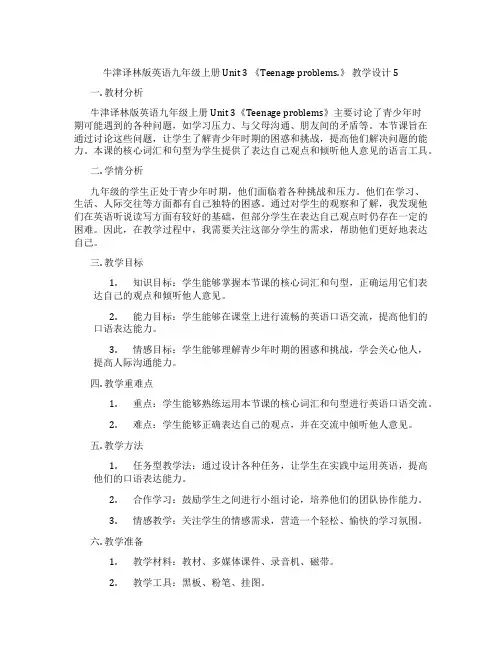
牛津译林版英语九年级上册 Unit 3 《Teenage problems.》教学设计5一. 教材分析牛津译林版英语九年级上册Unit 3《Teenage problems》主要讨论了青少年时期可能遇到的各种问题,如学习压力、与父母沟通、朋友间的矛盾等。
本节课旨在通过讨论这些问题,让学生了解青少年时期的困惑和挑战,提高他们解决问题的能力。
本课的核心词汇和句型为学生提供了表达自己观点和倾听他人意见的语言工具。
二. 学情分析九年级的学生正处于青少年时期,他们面临着各种挑战和压力。
他们在学习、生活、人际交往等方面都有自己独特的困惑。
通过对学生的观察和了解,我发现他们在英语听说读写方面有较好的基础,但部分学生在表达自己观点时仍存在一定的困难。
因此,在教学过程中,我需要关注这部分学生的需求,帮助他们更好地表达自己。
三. 教学目标1.知识目标:学生能够掌握本节课的核心词汇和句型,正确运用它们表达自己的观点和倾听他人意见。
2.能力目标:学生能够在课堂上进行流畅的英语口语交流,提高他们的口语表达能力。
3.情感目标:学生能够理解青少年时期的困惑和挑战,学会关心他人,提高人际沟通能力。
四. 教学重难点1.重点:学生能够熟练运用本节课的核心词汇和句型进行英语口语交流。
2.难点:学生能够正确表达自己的观点,并在交流中倾听他人意见。
五. 教学方法1.任务型教学法:通过设计各种任务,让学生在实践中运用英语,提高他们的口语表达能力。
2.合作学习:鼓励学生之间进行小组讨论,培养他们的团队协作能力。
3.情感教学:关注学生的情感需求,营造一个轻松、愉快的学习氛围。
六. 教学准备1.教学材料:教材、多媒体课件、录音机、磁带。
2.教学工具:黑板、粉笔、挂图。
七. 教学过程1.导入(5分钟)利用多媒体展示一些青少年时期常见的问题,如学习压力、与父母沟通等。
引导学生谈论这些问题,激发他们的兴趣。
2.呈现(10分钟)呈现本节课的核心词汇和句型,让学生通过听力练习和小组讨论来熟悉这些词汇和句型。
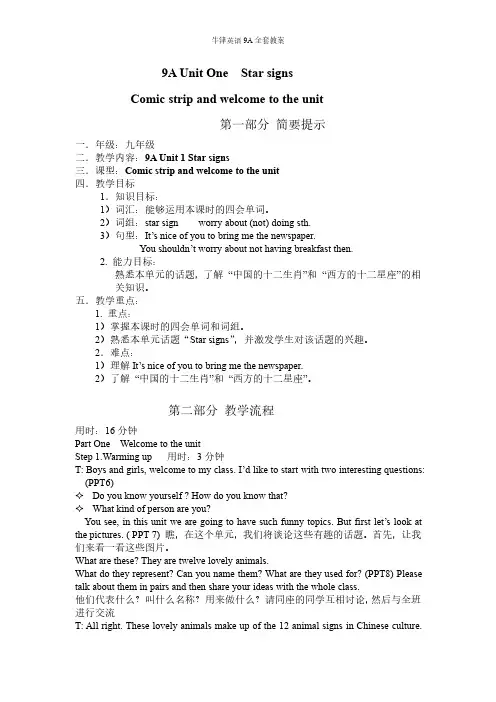
9A Unit One Star signsComic strip and welcome to the unit第一部分简要提示一.年级:九年级二.教学内容:9A Unit1Star signs三.课型:Comic strip and welcome to the unit四.教学目标1.知识目标:1)词汇:能够运用本课时的四会单词。
2)词组:star sign worry about(not)doing sth.3)句型:It’s nice of you to bring me the newspaper.You shouldn’t worry about not having breakfast then.2.能力目标:熟悉本单元的话题,了解“中国的十二生肖”和“西方的十二星座”的相关知识。
五.教学重点:1.重点:1)掌握本课时的四会单词和词组。
2)熟悉本单元话题“Star signs”,并激发学生对该话题的兴趣。
2.难点:1)理解It’s nice of you to bring me the newspaper.2)了解“中国的十二生肖”和“西方的十二星座”。
第二部分教学流程用时:16分钟Part One Welcome to the unitStep1.Warming up用时:3分钟T:Boys and girls,welcome to my class.I’d like to start with two interesting questions: (PPT6)✧Do you know yourself?How do you know that?✧What kind of person are you?You see,in this unit we are going to have such funny topics.But first let’s look at the pictures.(PPT7)瞧,在这个单元,我们将谈论这些有趣的话题。
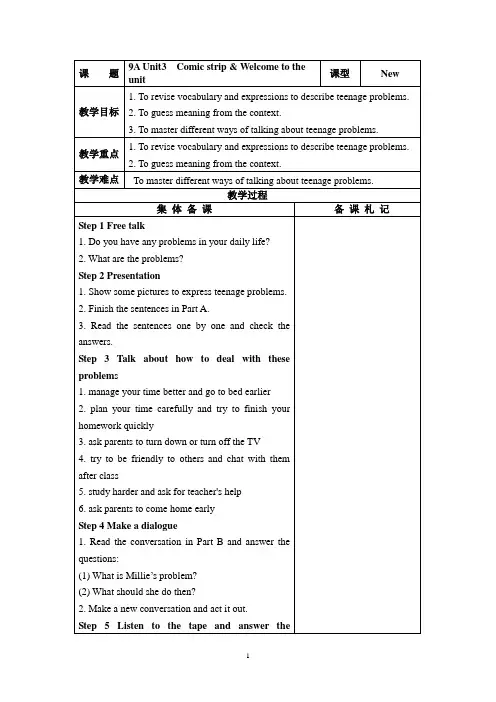
课题9A Unit3 Comic strip & Welcome to theunit课型New教学目标1. To revise vocabulary and expressions to describe teenage problems.2. To guess meaning from the context.3. To master different ways of talking about teenage problems.教学重点1. To revise vocabulary and expressions to describe teenage problems.2. To guess meaning from the context.教学难点To master different ways of talking about teenage problems.教学过程集体备课备课札记Step 1 Free talk1. Do you have any problems in your daily life?2. What are the problems?Step 2 Presentation1. Show some pictures to express teenage problems.2. Finish the sentences in Part A.3. Read the sentences one by one and check theanswers.Step 3Talk about how to deal with theseproblem s1. manage your time better and go to bed earlier2. plan your time carefully and try to finish yourhomework quickly3. ask parents to turn down or turn off the TV4. try to be friendly to others and chat with themafter class5. study harder and ask for teacher's help6. ask parents to come home earlyStep 4 Make a dialogue1. Read the conversation in Part B and answer thequestions:(1) What is Millie’s problem?(2) What should she do then?2. Make a new conversation and act it out.Step 5 Listen to the tape and answer thefollowing questions1. What problem does Eddie have? What i s Hobo’s advice?2. Why does Hobo tell Eddie not to eat too much? Step 6 Read and act it outStep 7 Fill in the blanksEddie has got a . He is getting . Hobo tells him not to too much because it is . He also tells Eddie to trymore . If Eddie does so, he willthe food for Eddie.Step 8 DiscussionWhat should (not) you do when you have some problems?Step 9 Homework1. Read the text book and learn the new words and phrases by heart.2. Recite the dialogue in Part B on page 35.3. Preview Reading.板书设计教学反思课题9A Unit 3 Reading (1) 课型New教学目标1. To guess general meanings from keywords and context.2. To skim text for overall meanings and scan for details.3. To identify specific information about Teenage problems.4. To use words to describe the Teenage problems.教学重点1. To guess general meanings from keywords and context.2. To skim text for overall meanings and scan for details.教学难点1. To identify specific information about Teenage problems.2. To use words to describe the Teenage problems.教学过程集体备课备课札记Step 1 Free talk1. What do you like to do during your free time?2. Do you like your school life in Grade 9? How do you feel? Why?3. What do you often do with your problems?Step 2 SkimmingT: … We can a lso write to newspapers and TV stations. Or sometimes we can write to youth workers like Sigmund Friend. Millie and Simon wrote two letters to him.Skim their letters and answer the two questions.1. What are Millie’s problems?2. What problems does Simon have?Finish the exercise in Part B2.Step 3 Learn some new wordsHere are some sentences in the two letters. And there are some new words in them. Can you read the new words? Read them again and try to understand the new words.Do the exercise in Part B1.Step 4 Read Millie’s letter and try to tell true or falseT: From the records we can see, Millie and Simon are feeling bad because of their problems. Do you want to help them to solve their problems? Let’s help Millie first. Listen to Millie’s letter and tel l true or false. (见课件)Step 5 Read Millie’s letter and fill in the blanket Name MillieGradeHobbiesProblems _____________ and hardly_______________________ Feeling often doubt whether_________Wish __________________ so thatshe can______________________Step 6 Have a debateT: Millie knows it’s important to do her homework. However, she hardly has any time for her hobbies. What should she focus on? Choose one and have a debate.From your debate, we can see Millie should achieve a balance between her homework and her hobbies.Step 7 Read Simon’s letter and find the sentences for the followingT: Now Read Simon’s letter loudly. Find the sentences to describe the following.Name SimonGradeHobbies Football, _______football and ___________ football.Problems Often _______________. However,hisparents____________________________Feeling Feels ___________ from time totime, because he _______Step 8 Give Simon and Millie some suggestions Finish the exercise in Part B3.Mr. Friend is rep lying to Millie’s and Simon’s letters. Help him complete the sentences with the words in the box.Step 9 Group workSimon and Millie must be happy because you give them so many suggestions. We will be happy too if we talk with others about our problem. 1. What is your problem? 2. How do you feel? 3. What are your friends’ suggestions? Work in groups and talk. Then I will ask you to come to the front to talk about your problems. Step 10 Homework1. Read aloud the article.2. Remember the new words in this lesson.板书设计教学反思课题9A Unit 3 Reading 2 课型New教学目标1. To review the details in the article.2. To learn the key phrases and drills in the article.3. To understand how to write about problems and to express feelings.教学重点To learn how to talk about problems and express feelings.教学难点To learn the key phrases and drills in the article.教学过程集体备课备课札记Step 1 Make a revision1. Ask students to read the two letters together.2. Answer some questions to remind them of the twoletters:① What is Millie’s problem?② What does she want Sigmund Friend to do?③ What is Simon’s probl em?④ What does he think of his parents?Step 2 PracticeShow two pictures of Millie and Simon, with words besidethem. Ask students to retell the two letters according tothem.Mille: lots of hobbies, a lot of homework, feel bad, focuson/ give up, achieve a balanceSimon: be crazy about, stay out late, parents stressed/angry, spend some time on hobbiesStep 3 Language points1.I don’t know how to deal with it.我不知道怎样处理它。
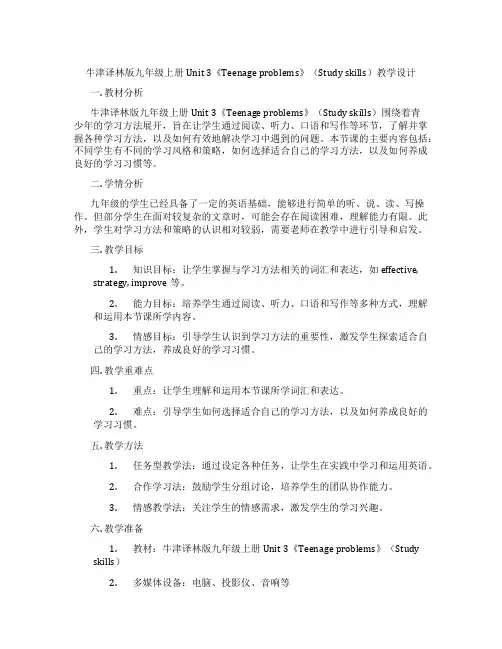
牛津译林版九年级上册Unit 3《Teenage problems》(Study skills)教学设计一. 教材分析牛津译林版九年级上册Unit 3《Teenage problems》(Study skills)围绕着青少年的学习方法展开,旨在让学生通过阅读、听力、口语和写作等环节,了解并掌握各种学习方法,以及如何有效地解决学习中遇到的问题。
本节课的主要内容包括:不同学生有不同的学习风格和策略,如何选择适合自己的学习方法,以及如何养成良好的学习习惯等。
二. 学情分析九年级的学生已经具备了一定的英语基础,能够进行简单的听、说、读、写操作。
但部分学生在面对较复杂的文章时,可能会存在阅读困难,理解能力有限。
此外,学生对学习方法和策略的认识相对较弱,需要老师在教学中进行引导和启发。
三. 教学目标1.知识目标:让学生掌握与学习方法相关的词汇和表达,如effective,strategy, improve等。
2.能力目标:培养学生通过阅读、听力、口语和写作等多种方式,理解和运用本节课所学内容。
3.情感目标:引导学生认识到学习方法的重要性,激发学生探索适合自己的学习方法,养成良好的学习习惯。
四. 教学重难点1.重点:让学生理解和运用本节课所学词汇和表达。
2.难点:引导学生如何选择适合自己的学习方法,以及如何养成良好的学习习惯。
五. 教学方法1.任务型教学法:通过设定各种任务,让学生在实践中学习和运用英语。
2.合作学习法:鼓励学生分组讨论,培养学生的团队协作能力。
3.情感教学法:关注学生的情感需求,激发学生的学习兴趣。
六. 教学准备1.教材:牛津译林版九年级上册Unit 3《Teenage problems》(Studyskills)2.多媒体设备:电脑、投影仪、音响等3.教学素材:相关学习方法的文章、视频等4.课件:制作与本节课相关的内容,包括词汇、图片、视频等七. 教学过程1.导入(5分钟)利用课件展示一些关于学习方法的名言,如“活到老,学到老”、“适合自己的才是最好的”等,引导学生思考如何选择适合自己的学习方法。
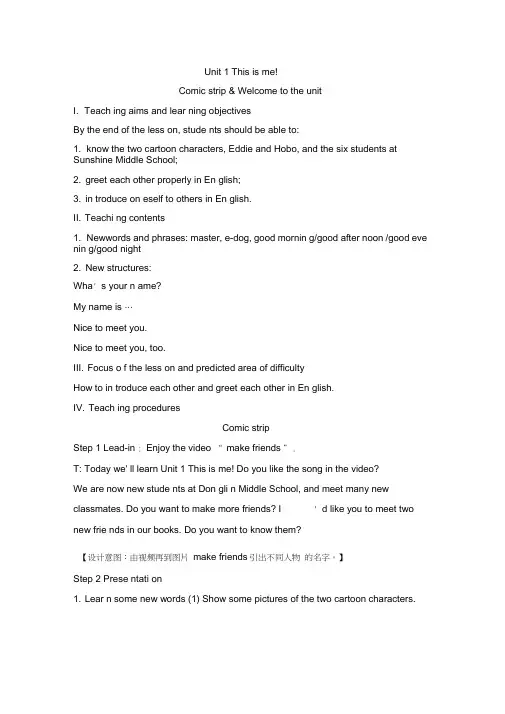
Unit 1 This is me!Comic strip & Welcome to the unitI. Teach ing aims and lear ning objectivesBy the end of the less on, stude nts should be able to:1. know the two cartoon characters, Eddie and Hobo, and the six students at Sunshine Middle School;2. greet each other properly in En glish;3. in troduce on eself to others in En glish.II. Teachi ng contents1. Newwords and phrases: master, e-dog, good mornin g/good after noon /good eve nin g/good night2. New structures:Wha' s your n ame?My name is …Nice to meet you.Nice to meet you, too.III. Focus o f the less on and predicted area of difficultyHow to in troduce each other and greet each other in En glish.IV. Teach ing proceduresComic stripStep 1 Lead-in : Enjoy the video “ make friends ”.T: Today we' ll learn Unit 1 This is me! Do you like the song in the video?We are now new stude nts at Don gli n Middle School, and meet many new classmates. Do you want to make more friends? I ' d like you to meet two new frie nds in our books. Do you want to know them?【设计意图:由视频再到图片make friends引出不同人物的名字。
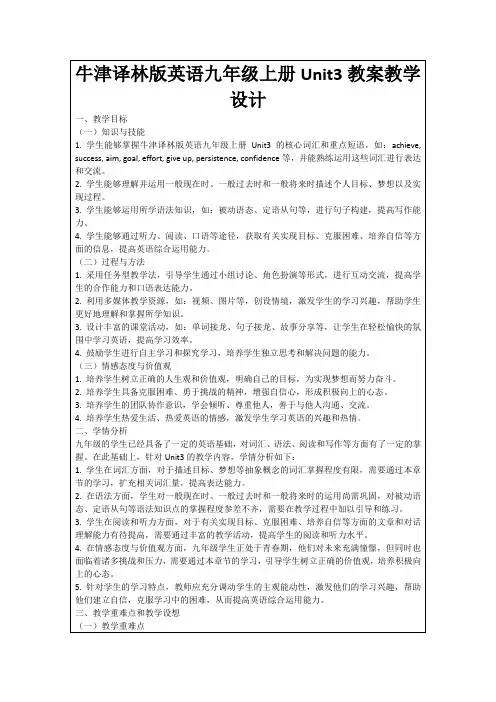
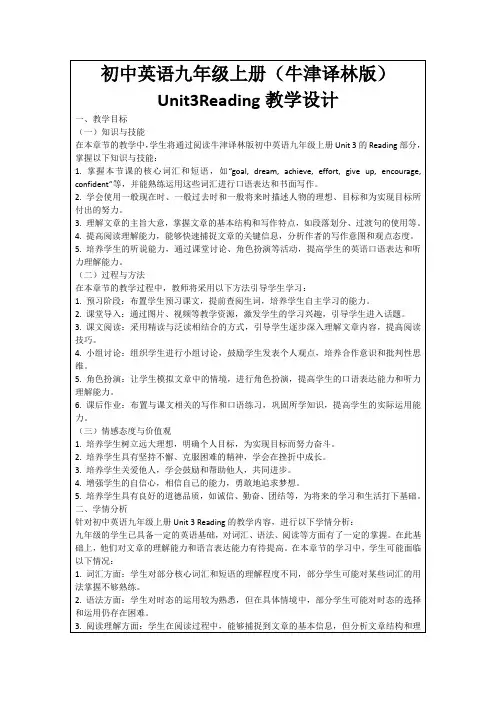
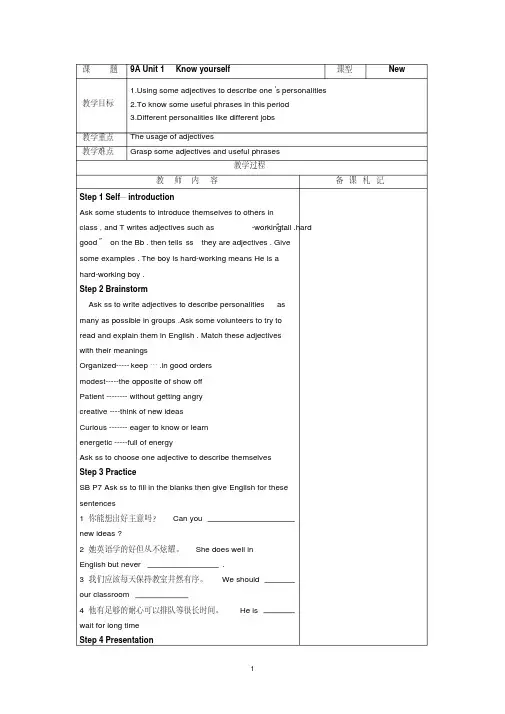
课题9A Unit 1 Know yourself 课型New教学目标ing some adjectives to describe one’s personalities2.To know some useful phrases in this period3.Different personalities like different jobs教学重点The usage of adjectives教学难点Grasp some adjectives and useful phrases教学过程教师内容备课札记Step 1 Self—introductionAsk some students to introduce themselves to others inclass , and T writes adjectives such as “tall .hard-working ,good” on the Bb . then tells ss they are adjectives . Givesome examples . The boy is hard-working means He is ahard-working boy .Step 2 BrainstormAsk ss to write adjectives to describe personalities asmany as possible in groups .Ask some volunteers to try toread and explain them in English . Match these adjectiveswith their meaningsOrganized-----keep….in good ordersmodest-----the opposite of show offPatient -------- without getting angrycreative ----think of new ideasCurious ------- eager to know or learnenergetic -----full of energyAsk ss to choose one adjective to describe themselvesStep 3 PracticeSB P7 Ask ss to fill in the blanks then give English for thesesentences1 你能想出好主意吗?Can younew ideas ?2 她英语学的好但从不炫耀。
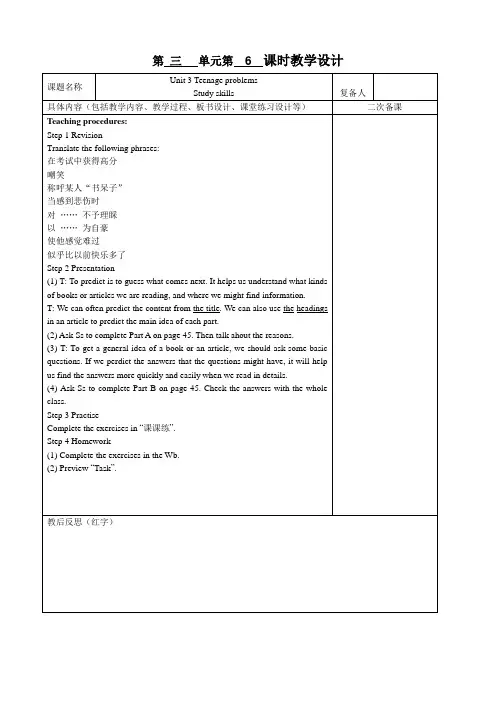
第三单元第 6 课时教学设计课题名称Unit 3 Teenage problemsStudy skills 复备人具体内容(包括教学内容、教学过程、板书设计、课堂练习设计等)二次备课Teaching procedures:Step 1 RevisionTranslate the following phrases:在考试中获得高分嘲笑称呼某人“书呆子”当感到悲伤时对……不予理睬以……为自豪使他感觉难过似乎比以前快乐多了Step 2 Presentation(1) T: To predict is to guess what comes next. It helps us understand what kindsof books or articles we are reading, and where we might find information.T: We can often predict the content from the title. We can also use the headingsin an article to predict the main idea of each part.(2) Ask Ss to complete Part A on page 45. Then talk ahout the reasons.(3) T: To get a general idea of a book or an article, we should ask some basicquestions. If we perdict the answers that the questions might have, it will helpus find the answers more quickly and easily when we read in details.(4) Ask Ss to complete Part B on page 45. Check the answers with the wholeclass.Step 3 PractiseComplete the exercises in “课课练”.Step 4 Homework(1) Complete the exercises in the Wb.(2) Preview “Task”.教后反思(红字)。
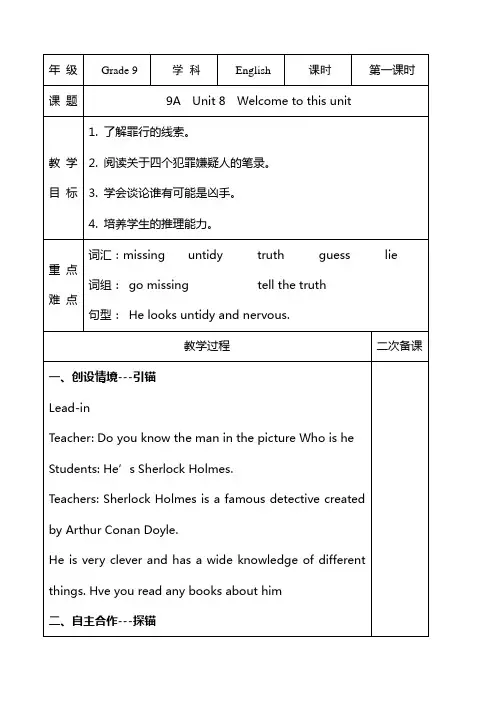
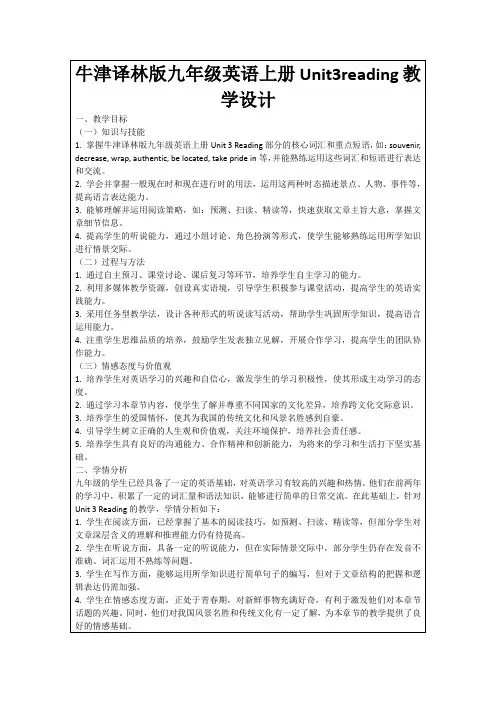
牛津译林版初中英语九年级上Unit5全单元教学设计牛津译林版初中英语九年级上《Unit5 Art world》教学设计侍岭中心学校课题课型 9A Unit5 Welcome to the unit New 主备人课时陈雷 1 执教授课陈雷 1.To learn the vocabulary about different arts 教学目标 2. To talk about their favorite art forms and explain the reasons 教学要点教学法指导教具准备集体智慧教学重点教学难点 To learn the key words and phrases To explain their love for arts Task based method CAI 个性设计教学Ask students 一、自主定向 to try to finish the 翻译下面词组 exercises 1.令人愉快的东西 2.热爱艺术 3.更令人愉快的 before 4.停止做 5.停下来做某事 6.艺术形式 class. 二、合作交流 Step 1 Lead in Teacher shows some pictures on the walls and let Ss guess who draw them and then show more paintings on the screen. Step 2 presentation Listen and answer the following questions 1. Why does Eddie stop there? 2. What do you think Eddie really loves? Check the answers and read after the tape in different forms in order to make Ss practice oral English. Step3 Find out something new, something important or something you can't . understand 1.Tell us how to use 'find'? 2. How much do you know about '不定代词'?3 How to use ?pleasant?, ?pleased?, ?pleasure?. 4. Do you know how to express“音乐家〞,“有才华的〞? 5. How to use “amazing〞 and “amazed〞? music (n) 音乐〔不可数〕 a piece of musicmusical (adj) 音乐的 musical talent musician (n) 音乐家 talent (n) 才华 talented (adj) 有才华的 He has a _____ of music. He is a _____ actor. amazing (adj )令人吃惊的〔修饰物〕 amazed (adj) 感到吃惊的〔修饰人〕 He is _____ at the _____ film. Step 4 Presentation Let Ss enjoy the pictures on Page65 and finish the exercises Play a guessing game about different kinds of music What art form do you like best? Why? What kind of art form do you like best? Listen and fill in the forms What kind of music does Daniel like best? Daniel’s favourite art form kind of music singer reasonTalk with your partners and give the answers to the questions. Step5 Work in pairs: A: What art form do you like? B: I like .... A: Really? What kind of ... do you like best? B: I prefer .... A: Who?s your favourite ...? B: I like ... best. A: Why do you like ...? B: Because .... 三、当堂评估用括号内所给单词的适当形式填空 1.Wish you a _________please)trip. 2. If you have a _______ (music) ability,you should use it. 3. I 've found something _____ (much) pleasant than art. 4. I find itinteresting__________(learn) English. 选择5. We didn?t learn _______ in this lesson. A. something difficult B. difficult something C. anything difficult D. difficult anything6.It's kind of you to help me finish the task. ---- __________________. A.It doesn't matter B.Never mind C.Don't mention it. D. My pleasure 板书设计 Unit5 Art world 1.令人愉快的东西 something pleasant 2.热爱艺术 love art 3.更令人愉快的 4.停止做 5.停下来做某事 stop to do sth 6.艺术形式art form牛津译林版初中英语九年级上《Unit5 Art World 》教学设计…...的兴趣 6.水流的速度二、合作交流 Step 1 Greeting Step 2 play a guessing game a world-famous composer/musician be known formake sound by controlling the speed of water flow make music with common objects instead of musical instruments use traditional Chinese music and the sounds of an ancient Chinese bell, in a western style It is Tan Dun. Step 3 practice Match the words with their meanings(the B1 on P68) Check the answers together Step 4 while reading Skim Go through the article quickly and answer the questions. 1. Who is the article about? 2. What is he? 3. What is he famous for? As a composer, what is Tan Dun best known for? Finish the exercise B2 Let the students skim the Paragraph 1—3 and answer the questions. Tell if the following sentences are true or false. If it is false, please correct it. ( ) 1. Tan Dun wrote music for the Beijing 2022 Olympic Games. ( ) 2. Tan Dun is a world-famous actor.( ) 1. Whenhe was young, Tan Dun was not interested in music. ( ) 2. Tan Dun once made music with tones and paper. ( ) 3. Tan Dun received both Eastern and Western musical education. ( ) 3. Tan Dun went on to study in the USA in 1985. Para 2 Tan?s special interest in music at a young age Read Paragraph 2 and find out how special Tan?s music is Tan?s interest in music He thinks the best music comes from nature Listen and answer the questions. Have a good influence on Tan Dun’s later music Para 3 Tan?s education and his Oscar music Read Paragraph 3 and find out Tan?s education experience. Education studied at Central Conservatory of Music in Beijing went on to study in the USA Para 4: Read and answer 1. What does Tan Dun use a lot in his music?…...的兴趣 6.水流的速度 the speed of water flow 牛津译林版初中英语九年级上《Unit5 Art world》教学设计侍岭中心学校课题课型教学目标教学要点 Reading 2 New 主备人课时陈雷 3 执教者授课时间陈雷 1.To understand how to talk about arts and to express love for arts 2.To recognize and understand vocabulary about arts 教学重点教学难点 Key words and phrases Key phrases and sentences Task based method 教学法指导。
九年级上册英语全册教案Unit 1 Know yourselfWelcome to the unit教学目标By the end of the lesson:Students can talk about personalities.Students can master some useful expressions.Students can use some adjectives to describe one’s personalities.教学重点1. To let students know the background of different places in the world and talk about them.2. The usage of adjectives.教学难点How to talk about personalities effectively.How to grasp some adjectives and useful phrases.教学过程Step 1 Lead inTeacher says, ‘Hello, everybody! We haven’t seen each other for a long time. Were you happy in winter holidays? Did you have a good time? Where did you go? What did you do? What did you eat? What food is your favourite? Have you visit your best friends?’ Introduce your best friend with different adj.Eg: creative adj. 有创造力的;创造性的curious adj.好奇的energetic adj.精力充沛的modest adj.谦虚的organized(=organised) adj. 有条理的;有效率的Ask students to practice reading the words I introduced just now.Step 2 BrainstormAsk ss to write adjectives to describe personalities as many as possible in groups. Ask some volunteers to try to read and explain them in English. Match these adjectives with their meaningsOrganized -----keep…in good orders modest-----the opposite of show off Patient -------- without getting angry creative ----think of new ideas Curious ------- eager to know or learn energetic -----full of energyAsk ss to choose one adjective to describe themselvesStep 3 Presentation1. Teacher asks, do you still remember Hobo and Eddie? How are they this term? What are they talking about now? Let’s listen to the tape. (Play the tape for the Ss to listen to the dialogue between Hobo and Eddie.)2. Ask some questions about it:What makes generous people feel good?Is Eddie really generous?Why did Hobo eat up all the breakfast?Step 4 ExplanationExplain the important phrases and sentences in the dialogue.Step 5 Practice1. Work in pairs and drill the dialogue.2. Ask some Ss to act the dialogue out.Step 6 PresentationA. Some words are often used to describe people's personalities.Help Millie complete the following sentences with the words in the box.B. Millie and her classmates are talking about their own personalities and the kind of job they like or dislike. Work in groups and talk about yourselves.Use the conversation below as a model.C. Explain and Practice using the following phrases and sentences.keeps all her things in good order.shows offrepeat grammar rules for us.comes up withNeither my parents nor I think I can make a good accountant.It's terrible for me to work without speaking all day long.Step 7 Homework1. Recite the important sentences.2. Preview Reading.Unit 1 Know yourselfReading(Ⅰ)Teaching objectivesBy the end of the lesson, students should be able to:1. guess the meanings of the new words from the context;2. talk about jobs and personalities;3. identify the main idea of each paragraph in the passage by skimming;4. describe the four people’s jobs and personalities by detailed reading;5.improve their reading abilities.Important pointsHow to talk about jobs and personalities with some new expressions.Teaching contents1. New words and phrases:born, impress, sculpture, praise, sales department, general,race, either or, lead, take the lead, fall behind, challenge,chief, high-speed, connect, connect to/with, miss, as goodas, attention, pay attention to, standard, pioneer, surgeon,carelessness, extra, devote, respect, suitable, partner2. New structures:Life is like a race. You either take the lead or fall behind.A miss is as good as a mile.As a doctor, you can’t be too careful.III. Focus of the lesson and predicted area of difficulty1. To read the passage in different ways;2. To describe four people’s jobs and personalities by detailed reading.IV.Teaching proceduresStep 1 Warming-upFree talkT: Today, we’ll meet some outstanding people. They like their jobs very much. Now show me your ideas, what kind of person are they?Step 2 Pre-reading1. Watch a videoT: Who is this man? Let’s watch a video first.T: You know him very well. He is the pioneer of Alibaba. He is devoting most of his time to it.He says, “If not now, when? If not me, who?” Any time he is ready to take onnew challenges. He always works to high standards. Now he is one of the richest in China. So people often say he is a born businessman.2. PredictionT: Look at these pictures from Sunshine Town. They are also outstanding in their fields. Would you please guess what their jobs are?Step 3 While-reading1. SkimmingT: Now please look through the text quickly and check if you have made the rightprediction, also try to find what they think of their jobs.T: Yes, Wu Wei is an artist, Su Ning is a manager, Liu Tao is an engineer, and Fang Yuan is a doctor. What do they think of their jobs?T: Yeah, they are happy with their jobs. How can you get the information quickly? T: Great! Pay attention to the title and the pictures while reading.2. ScanningPassage 1:(1) Read and answerT: Now let’s read Passage 1 more carefully and answer two questions:●What does Wu Wei’s best friend think of him?●What has won Wu Wei high praise from the art community?T: Yes, his best friend said, “He is a born artist. He’s quiet and doesn’t like to talk much, but his work shouts.” And his sculptures for Sunshine Town Square have won high praise from the art community.(2) Read and guessT: Good job! Let’s do some guessing work. What does “his work shouts” mean here?T: Yes, that is to say his work is wonderful. Then what about “praise”? What does it mean?T: Excellent! How can we guess the meaning of new words?T: I agree. Circle some key words before and after the new word or the sentence.It’s possible to find its meaning.(3) Read and thinkT: Wu Wei said, “I want to share the best art with people, so I’m always searching for something better or different. This in itself is great fun.” What can you infer from it?T: I love all your ideas. He is so creative and of course he is happy with his job. Passage 2:Read and finishT: Find out some information about Su Ning’s past and present.five years ago•was an __________•only worked with ______•made me _______(accountant, numbers, unhappy) now•is a general manager•is active and _________•love working with ________•is ready to take on ________ any time (energetic, people, challenges)Passage 3:Read and practicePassage 4:An interview between groupsT: Read through Passage 4 and do an interview with Fang Yuan in pairs. Try to ask more questions and give detailed answers. The team which gets the most stars will be the winner.3.Further reading(1) ThinkingT: What do the sentences mean? Choose the right Chinese meaning, and try to find out some supporting sentences.●Life is like a race. You either take the lead or fall behind.● A miss is as good as a mile.●As a doctor, you can’t be too careful.(2) Listen and circleT: Now I’ve collected many words about their personalities. Please circle them in your books and try to match the words with the four persons.T: OK, Wu Wei is quiet and creative. Su Ning is active and energetic. Liu Tao is serious, organized and modest. Fang Yuan is kind, patient and careful. Different people have different personalities, and they also have different jobs. Are the jobs suitable for them? Why? You may use the sentences in the text to support your ideas.Step 4 Post-reading1.Listen and adviseT: The four persons here are all happy with their present jobs, and the jobs are suitable for them. Now let’s listen to a short conversation from Cindy, Stone and Tiantian.Write down their future jobs.T: Stone would like to be an engineer, Cindy hopes to be an artist, and Tiantian prefers to be a manager. Would you please give them some advice so that their personalities can match the job requirements.2.Share and reportT: It’s your turn to talk about yourselves. Think about what job you want to do in the future and if your personality matches the job requirements. You can share your ideas in groups, and then speak in front of the class.T: I hope you all can have a bright future. In your daily life, you should form good personalities to get ready for the future job. I believe finally you can be the one that you want to be.Homework1. Search more articles about people who are outstanding in their fields and try to make notes.2. Finish your own article about jobs and personalities and read it to your friend.Unit 1 Know yourselfReading (Ⅰ)Teaching objectivesBy the end of the lesson, students should be able to:1. describe people’s jobs and personalities by using what they learn in this period;2. talk about what the four people do and their personalities;3. have a better sense of working hard and being outstanding;4. understand vocabulary about characteristics and other important words.Important points1.To recognize and understand the important phrases;2. To use the new words and phrases to describe people’s personalities and jobs.Teaching contents1. New words and phrases: born, impress, sculpture, praise, sales department, general,race, either or, lead, take the lead, fall behind, challenge,chief, high-speed, connect, connect to/with, miss, as goodas, attention, pay attention to, standard, pioneer, surgeon,carelessness, extra, devote, respect, suitable, partner2. New structures: Life is like a race. You either take the lead or fall behind.As a doctor, you can’t be too careful.Carelessness will be a disaster not only to ourselves but also to patients.Teaching proceduresStep 1 Lead-inT: Guess who he is. He is the great Greek philosopher—Socrates and he once said, “Know yourself, and then you can understand life.”Step 2 ReviewingT: Knowing yourself is very important. Do the four outstanding people know themselves very well? Now you’ll be divided into four groups: Su Ning Group, Wu Wei Group, Liu Hao Group and Fang Yuan Group. Su Ning and Wu Wei Groups will discuss who is suitable for the general manager of a big company. Liu Hao and Fang Yuan Groups will discuss whether you are suitable for your jobs. Give your reasons. Step 3 DiscussionT: What’s your favourite saying? Why?Step 4 Language pointsPresent and practice the important words and expressions mentioned in the discussion.1. Life is like a race. You either take the lead or fall behind.T: Look at the picture of Liu Xiang.Liu Xiang is taking the lead in the race.The other top players are falling behind in the race.T: You know the story of the hare and tortoise. Can you say something about it? S: The hare is taking the lead. The tortoise is falling behind.T: In this race, either the hare or tortoise will win.2.either ... or ...T: If you’re planning a day out, what will you choose to do? Use “either … or …”to make a conversation3. It’s necessaryto pay attention to every detail.T: When you go on an outing, what should you pay attention to?S: …T: pay attention to sth. 注意某事pay attention to doing sth. 注意做某事Try to complete the sentences:Pay attention to protecting the environment.Successful businessmen always pay attention to details.4. I’m ready to take on new challenges any time.Present new structures “take on new challenges”, “connect … to …” by talking about Ma Yun.T: Ma Yun and Bill Gates are both successful businessmen. Ma Yun likes taking on new challenges. He owns Alibaba, Taobao, China Yahoo, etc. He has connect ed the Internet to people’s life.It’s your turn to talk about Bill Gates.5. He has impress ed the whole country with his work.T: Ma Yun and Bill Gates has impressed us with their creative ideas. Have youheard about a disabled young girl called Liao Zhi, whose legs were hurt during an earthquake? What about Nick Vujicic, a famous speaker with no arms andlegs?(1) Liao Zhi, the young disabled dancer, has impressed the country with herwonderful spirit and dancing skills.(2)Nick Vujicic has no arms or legs, but he has impressed the whole world with his speeches.Practice (Open task):Watch a video about Nick Vujicic and Practice:Nick ________________ me with ___________________.6. Carelessness will be a disaster not only to ourselves but also to patientsT: Nick Vujicic can not only choose how to live but also face problems bravely.Now look at these two pictures. Use “not only … but also” to make one sentence. T: So Not only my husband but also my daughter likes him very much. Some tips for you.Careless is a humorous film. Not only children but also adults like it.7.carelessnessT: Learn to use “care”, “careful”, “careless”, “carelessly” and “carelessness”. After that, try to make a summary about them.●Take _______. The bus is coming.●Be ________ with fire. It can be dangerous.●The less __________, the fewer mistakes.●Pay attention to your safety. Don’t drive ___________.●_________________ will lead to accidents.8. As a doctor, you can’t be too careful.T: As a driver, don’t drive carelessly. Carelessness will lead to accidents. Thatmeans you can’t be too careful when driving.T: Would you please talk about your ideas? As a student/teacher/…, you can’t be too _________. In a word, one can’t be too modest.Step 5 Other words and phrasesT: Read the four passages again. Underline all the new words and phrases and see if you understand them.Step 6 Practice1. Use some of the new phrases to complete the sentences2. DescriptionChoose at least four phrases to talk about your hero.(1) a born …(2) win high praise from(3) either … or …/not only … but also …(4) take the lead/fall behind(5) be ready to/ be willing to …(6) take on new challenges(7) connect … to …(8) pay attention to …(9) work to high standardsStep 7 Myfavourite sayingT: The American educator, Samuel Bubler once said, “Every man’s work, whether it be literature or music or pictures or architecture or anything else, is always a portrait of himself.” So love what we do.HomeworkWrite about your hero’s personality and job, and share it in your groups.Unit 1 Know yourselfGrammarTeaching goalsKnowledge and skills:To master the usage of conjunctions like and but or and so.Process and method:Listening,speaking,reading.Emotion and attitude:Use conjunctions to join ideas together.Important and difficult points1. Use conjunctions to join ideas together.2. Use conjunctions to join ideas together.Teaching proceduresA Using and, but, or and soStep 1 Lead inFree talkT: Today, we’ll learn Grammar of Unit 1. We’ve met four outstanding persons. Do you remember them? (Show the pictures of the characters we’ve learned.)S: They are Wu Wei, Su Ning, Liu Tao and Fang Yuan.T: Among them, I admire Wu Wei the most because I wanted to be an artist when I was young.Step 2 Presentation1. BrainstormingT: How much do you know about Wu Wei?workshobby personalitysayingWu WeiS: He is quiet and doesn’t like to talk much.S: He impressed the whole country with his creative work.S: I want to share the best art with people, so I’m always searching for something better or different.T: Do you know something about his hobby? Let’s listen together.(Wu Wei: I like doing something quiet like fishing and watching TV. I don’t like singing or dancing)S: He likes fishing and watching TV. He doesn’t like singing or dancing.Step 3 Practice1. Show the picture of Wu WeiT: Wu Wei likes reading and watching TV. Guess what TV programmes he likes watching.S: …(Play the theme songs of two TV programmes.)T: He likes watching “the V oice of China” and “Dad, where are we going?” like you and me. Let’s talk about “the V oice of China” first.2. Show some pictures of the programmesAsk the students to describe the pictures, and join the sentences together with and, but, or or so.(1) We can watch the programmes on TV. We can watch the programmes on the Internet.We can watch the programmes on TV or on the Internet.(2) The rules of the programmes are special. Many people are interested in it.The rules of the programmes are special so many people are interested in it.(3) The coaches sit with their backs to the singers. They listen carefully.The coaches sit with their backs to the singers, but they listen carefully.(4) The girl sang very well. Four coaches all turned their chairs.The girl sang very well, so four coaches all turned their chairs.(5) She didn’t choose Yang Kun. She didn’t choose Qi Qin. She chose Na Ying.She didn’t choose Yang Kun or Qi Qin.She thought twice, and she chose Na Ying finally. (think twice: 三思,再三考虑)Step 4 Production1. DiscussionT: We often use and, but, or and so to join ideas together. Let’s have a discussion: When we join ideas together, how should we use these conjunctions?and join different ideasbut introduce another possibility/join two or more ideas (in negative sentences)so join similar ideasor express the results of something2. Finish the exercises on Page 123. Game timeT: You are so great. Now, let’s play a game to see which group will be the winner.Here are the rules: You are divided into 4 groups. Try to make sentences with and, but, or and so. If the first student in Group1 makes a sentence correctly, thenhe’ll have the chance to ask the first one in Group 2 to make a sentence with any word of the four … If you can’t make a sentence in 5 seconds, your group will lose the game.B Using both … and …, not only … but (also) …, either … or … and neither … nor …Step 1 Lead inFree talkT: Just now, we talked about “the V oice of China”. You’ve done a good job. What other programme does Wu Wei like?S: It’s “Dad, where are we going?”T: This programme is popular this year. I also like watching it.Step 2 Presentation1. Talk about “Dad, where are we going?”(1) The show is popular in China. The show is popular in other countries.The show is popular not only in China but also in other countries.The show is popular not only in China but in other countries.T: Who take part in the show?(2) Dads take part in the show. Their kids take part in the show.Not only Dads but also their kids take part in the show.Both dads and their kids take part in the show.(3) Feynman is five years old. Joe is five years old too.Not only Feynman but also Joe is five years old.Both Feynman and Joe are five years old.(4) Joe isn’t happy. Grace isn’t happy.Neither Joe nor Grace is happy.(5) The boy is so lovely. We call him Yang Yangyang. In fact, his name is Yang Wenchang.We can call him either Yang Yangyang or Yang Wenchang.(6) The two boys are wrestling. Either Joe or Feynman does better in wrestling. 2. DiscussionPlease read all these sentences by yourselves. Then discuss two questions: How should we use these conjunctions? How should we use the verb form?We use _________ to emphasize that something is true not just of one person, thing or situation but of another too.We use __________ to add another fact to something you have mentioned.We use __________ to mean one or the other, this or that, he or she, etc.We use __________ to mean not this one and the other, not this and not that, not he and not she etc.Step 3 Practice1. Finish B1 on Page 142. Finish B2 on Page 143. A competitionAmy made an interview in her class. Look at the form carefully, and try to get the information. Then, let’s have a competition in groups. Try to make as manysentences as possible with conjunctions we have learned. One of your group members should write them down. If your group gets the most sentences, you are the winner. For example: Nancy is both creative and curious.Step 4 ProductionT: All of you have done a good job! Let’s enjoy a poem together to relax.T: We all know that this poem is about my dream. Now it’s your turn to write about your dream or your school life. You can use this poem as a model.T: When we write, we can use conjunctions if necessary. Keep trying, and I think you can write something beautiful one day!V. Homework1. Interview two of your classmates about their personalities and future jobs;2. Write a short report about the interview. Try to use conjunctions.教学反思Unit 1 Know yourselfIntegrated skillsTeaching goalsKnowledge and skills:To get specific information from a listening material.Process and method:To talk about personalities.Emotion and attitude:To talk about animal signs.Important and difficult points1.To listen to the tape and get information about the radio programme.2. To learn about Chinese animal signs and personalities.Teaching proceduresStep1 Lead in1. Show the animal signs and English names.Rat horse ox sheep tiger monkey rabbit rooster dragon dog snake pig2. What do you think of monkeys? They are clever.3. New words lunar calendar animal sign represent appear fixed order cycle powerful lively practical loyalStep 2Listening1. Read A1, try to finish A2 with as much information as possible.2. Listen to the tape without writing.3. New words divide divide ...into... Shape4. Finish A35. Read A3.Speak up:We can read about them for fun.Step3 Presentation1. Is it true that people born under the same animal sign or star sign may have similar personalities? It may be true,but we shouldn’t believe in them. Let’s listen to a conversation between Millie and her neighbour Joe. Then answer these questions:1) What is Joe’s animal sign?2) What are people born in the year of the Tiger like?3) Whose animal sign is the sheep?4) What is Julie like?5) What does Millie think of the relationship between signs and personalities?2. Revise born brave in some ways that’s not the caseGentle believe inStep 4 Activities1. Practice in pairs.It is said that... It says that...I’m not sure... I agree/ disagreeI (don’t) think... That’s not the case.What about?2. Show their conversation.Step 5 Homework.Recite speak up.Blackboard Designappear in a fixed order every 12 yearsin all decide your personalitythe year of the Rabbit divide ... intoIt is you who shape your life and your future.People born under the same animal sign课堂检测动词填空1.You are the most suitable _______________(take) this job.2.—Where’s your brother?—He _________(do) an operation.3.What a creative artist! He ______________(impress) the whole country with the sculpture.4.We can’t afford ____________(fall) behind our classmate.5.You can go and play tennis only when your report ____________(finish).6.When I went to visit him yesterday, he ____________(read) a magazine about personalities.Homework1. Read A3 on page 16 and try to remember more information;2. Practice talking about animals and personalities with your partner;3. Write down your own ideas about what decides your personality.Teaching reflectionUnit 1 Know yourselfStudy skillsTeaching objectsKnowledge and skills:To get specific information of skimming.Process and method:How to skim.Emotion and attitude:To talk about skimming.Important and difficult points1. Learn to skim an article.2. Learn to skim an article.Teaching contentStep 1 Lead in1. Free talkT: Boys and girls, can you tell me what you often do when you are free?S: …T: We have a lot of things to do in our spare time. Do you want to know about my hobby? You can find it by finishing the saying: ______ are the stepping stones of human progress.S:Books.T: Yes. Books are the stepping stones of human progress. I spend much time reading books every day because I think reading brings us everything. Do you like reading books?S: Yes, of course.T: I’d like to tell you a piece of good news. Our school will set up a reading club. If you want to join the club, please answer three questions about the reading skills.Let’s do it together.Step 2 Presentation1. Understand the meaning of the skimming(1) T: Now, the first question is “What is skimming?” If you don’t know the answer,it doesn’t matter. I’ll help you.(2) Show the picture of “skim stones”, and talk about it.T: Look at the picture. What’s the young man doing?T: He is playing a game called “skim stones”. People try to throw a little stone onto the surface of the water, and make it float on the surface as far as possible before it sinks. And here “skim” means “漂过” or “略过”.(3) Make a choiceT: So, what does skimming mean while reading? Of the two idioms, which is more similar to “skimming”, “字斟句酌” or “浮光掠影”?T: I agree with you. “浮光掠影” is closer to skimming. What does “浮光掠影”mean in Chinese?T: So, when skimming, do we read fast or slowly? Do we expect to get the main idea or specific information?S: …T: Skimming means reading the text quickly to get the main idea. You can understand the word in this way: “s” stands for the speed of the reading;“m”means the main idea. I hope it will help you understand “skim” better.2. Learn how to skim when readingT: Since you have understood the meaning of “skimming”, let’s come to the second question: How to skim when reading? That is to say, how can we read fast and get the main idea at the same time?(1) Show the reading process of four people. Ask students to tell if they are skimming.(2) Discussion: In Which part of the text can we find the main idea quickly?(3) Draw the conclusion: When skimming, read the title, the main headings, the firstand last paragraphs, and the first sentence of each paragraph.3. Find the main idea of the article by skimmingT: You’ve done a good job. The last task is to find the main idea of an article by skimming in one minute. I’ll give you three questions to help you:(1) What is the article about?(2) Is it true that some aspects of your personality are formed by nature?(3) What can change your personality?T: As you have answered three questions correctly, you have the chance to be the member the reading club.Step 3 Practice1. A competitionT: Now, let’s have a competition. We will vote for the best readers in our class. Who can find the main ideas of the following articles in the shortest time will be the best readers in our class.2. T: We all know that reading is a good habit to all of us. Let’s share a saying aboutreading: Reading ten thousand books is like travelling ten thousand miles. In Chinese, we say “读万卷书,行万里路”. Actually, we have different ways of reading. Sometimes, skimming is useful. Sometimes, we need to get the specific information. Join the reading club, and more reading activities are waiting for you!课堂检测一、根据句意和所给汉英释义写出单词1. He ________________(分成)a cake into pieces and gave them out to his children.2. Jack enjoyed reading all kinds of books. These books ______________(塑造)his ideals about the world.3. Nora’s birthday is not in this year’s ______________(日历). Do you know why?4. It was nearly half an hour before the bus __________________(start to be seen) at the street corner.5. Linda is a _____________________(full of energy,very active)girl. We all like her.6. Our classes begin and finish at ______________(not changing) times.Homework1. Skim one or two articles to get main idea;2. Search the Internet to know more about reading skills.教学反思Unit 1 Know yourselfTask。